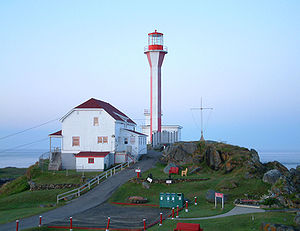
Cape Forchu ( /fɔːrˈʃuː/ for-SHOO) [1] is a Canadian fishing community and headland of the same name in Yarmouth County, Nova Scotia.

Cape Forchu ( /fɔːrˈʃuː/ for-SHOO) [1] is a Canadian fishing community and headland of the same name in Yarmouth County, Nova Scotia.
During the 17th and 18th centuries, fishing, water transportation and trade were essential to everyday life in Cape Forchu. During the American Revolution, in December 1775, American privateers took four vessels at Cape Forchu and took the people of the hamlet prisoners. [2] [3] During the 19th century, Yarmouth Harbour became a major port of registry for sailing ships and by the late 19th century, it was the second largest port of registry in Canada.
Shipwrecks were common along the shoreline and it was recommended by Colonel Robert Morse in 1874 that a chain of lighthouses should be built along the shores of Nova Scotia hence the construction of the Cape Forchu Lighthouse in 1840. This light station was replaced in 1962 with the "apple core" - a concrete tower. Since 2000, the original fresnel lens used at the lighthouse is located at the Yarmouth County Museum. At Cape Forchu there is an outcrop of the ancient supercontinent Gondwana. [4]
The 2019 film The Lighthouse , directed by Robert Eggers and starring Robert Pattinson and Willem Dafoe, was shot almost entirely on Cape Forchu. [5] For the exteriors shots, producers built a full-scale, 70-foot lighthouse tower on the cape that could withstand 120-kilometre winds. [6]
The original 1840 lighthouse, demolished in 1961, was featured on a postage stamp in 2022, one of five Vintage Travel Posters stamps issued on June 9. The stamps had been planned for release in 2020, but were twice delayed due to the COVID-19 pandemic. The stamp shows the old lighthouse as it appears on a 1950 poster designed by Peter Ewart, promoting “Canada’s Picturesque East Coast” for Canadian Pacific.

Cape Breton Island is a rugged and irregularly shaped island on the Atlantic coast of North America and part of the province of Nova Scotia, Canada.
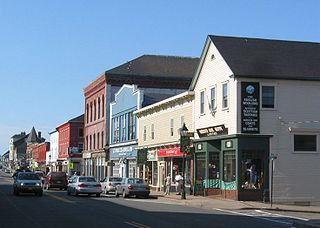
Yarmouth is a town in southwestern Nova Scotia, Canada. A port town, industries include fishing, and tourism. It is the terminus of a ferry service to Bar Harbor, Maine, run by Bay Ferries.

Liverpool is a Canadian community and former town located along the Atlantic Ocean of the Province of Nova Scotia's South Shore. It is situated within the Region of Queens Municipality which is the local governmental unit that comprises all of Queens County, Nova Scotia.
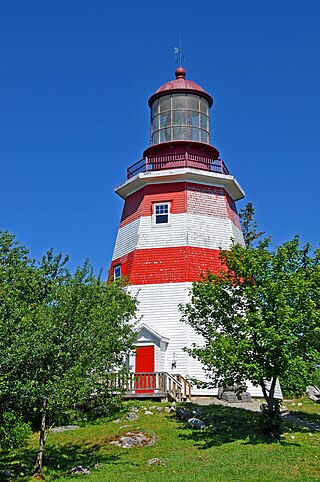
Barrington, officially named the Municipality of the District of Barrington, is a district municipality in western Shelburne County, Nova Scotia, Canada. Statistics Canada classifies the district municipality as a municipal district.

Mulgrave is a town on the Strait of Canso in Guysborough County, Nova Scotia, Canada. Located along the Marine Drive, Route 344 traverses the community. The town's current name was adopted in 1859 to honour the colonial Lieutenant Governor, the Earl of Mulgrave. Lying opposite to the town of Port Hawkesbury, the community is located along the western shore of the Canso Strait. It was established as McNair's Cove in the early 19th century, and the name Port Mulgrave was adopted in 1859, later shortening to its current form. The early industry of the community relied on ferry service between the Nova Scotia mainland and Cape Breton Island. Ferry service began in the 1810s and rail service reached the area in the 1880s. The ferry services lasted until the opening of the Canso Causeway in 1955, dealing a major blow to the local economy. As of 2016, Mulgrave has a population of 722 and a population density of 40.5/km2 (104.9/sq mi), within an area of 17.83 km2 (6.88 sq mi).

Yarmouth, officially named the Municipality of the District of Yarmouth, is a district municipality in Yarmouth County, Nova Scotia, Canada. Statistics Canada classifies the district municipality as a municipal district.
Chebogue is a small fishing village situated above the marshes of the Chebogue River in Yarmouth County, Nova Scotia. Farming and fishing are the two main resources in the area.

The Cape Forchu Lighthouse is located in Cape Forchu, Nova Scotia. The lighthouse is located 11 km from Yarmouth, Nova Scotia.

Seal Island is an island on the outermost extreme of Southwestern Nova Scotia, Canada, in the Municipality of the District of Argyle in Yarmouth County. It is approximately 4.3 kilometres (2.7 mi) long and 0.8 kilometres (0.50 mi) wide and is surrounded on its east, south and west sides by dangerous shoals. It is surrounded by the Atlantic Ocean and is the biggest of a group of five islands which extend north for 12 kilometres (7.5 mi). It is the second southernmost point of land of Nova Scotia. The southern tip of nearby Cape Sable Island is 250 metres (820 ft) farther south than the southern tip of land on Seal Island.

The Yarmouth County Museum & Archives is a museum located in Yarmouth, Nova Scotia, Canada. This museum explores the history of Yarmouth County. Located in the heart of Yarmouth's heritage residential district, the museum is housed in a former church as well as two historic houses. It also operates a summer display in the restored Killam Brothers Shipping Office on the Yarmouth waterfront.
Johns Cove is a small bay located on the Cape Forchu peninsula in the Municipality of Yarmouth, Nova Scotia. The cove is located in Yarmouth Sound and until the cancellation of the service in 2009 the CAT Ferry could be seen arriving and departing Yarmouth Harbour. Johns Cove is located 4 kilometers away from the town of Yarmouth. The beach is a popular destination for residents from Yarmouth due to its close proximity.
The history of lighthouses in Canada dates back to 1734.
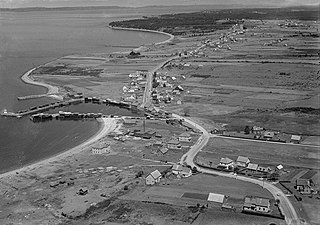
Belliveau Cove is a historical Acadian community in the Canadian province of Nova Scotia, located in the District of Clare in Digby County settled in 1768 on un-ceded Mi'kmaq territory. A major centre of wooden shipbuilding in the 19th and early 20th century, Belliveau Cove built the second largest wooden ship ever constructed in Canada, the County of Yarmouth in 1884. It is now a mixed community of citizens with diverse backgrounds, including Acadians.


Low Point Lighthouse is an historic Canadian lighthouse marking the eastern entrance to Sydney Harbour at New Victoria, Nova Scotia, near New Waterford, Nova Scotia. This is one of the earliest and most important light stations of Nova Scotia, one of the first dozen beacons in Nova Scotia to be lit to guide mariners, a classic red-and-white lighthouse still operated by the Canadian Coast Guard.
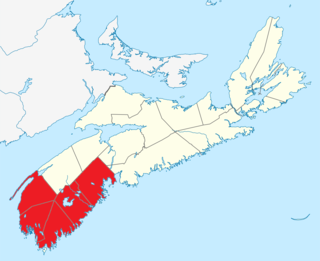
Southern Nova Scotia or the South Shore is a region of Nova Scotia, Canada. The area has no formal identity and is variously defined by geographic, county and other political boundaries. Statistics Canada, defines Southern Nova Scotia as an economic region, composed of Lunenburg County, Queens County, Shelburne County, Yarmouth County, and Digby County. According to Statistics Canada, the region had the highest decrease of population in Canada from 2009 to 2010, with a population decrease of 10.2 residents per thousand. The region also has the second-highest median age in Canada at 47.1 years old.
The Raid on Yarmouth took place on 5 December 1775 during the American Revolutionary War. The raid involved American Privateers from Salem, Massachusetts attacking Yarmouth, Nova Scotia at Cape Forchu. The privateers intended to stop the export of supplies being sent from Nova Scotia to the loyalists in Boston.
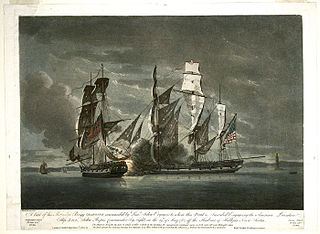
The Province of Nova Scotia was heavily involved in the American Revolutionary War (1776–1783). At that time, Nova Scotia also included present-day New Brunswick until that colony was created in 1784. The Revolution had a significant impact on shaping Nova Scotia, "almost the 14th American Colony". At the beginning, there was ambivalence in Nova Scotia over whether the colony should join the Americans in the war against Britain. Largely as a result of American privateer raids on Nova Scotia villages, as the war continued, the population of Nova Scotia solidified their support for the British. Nova Scotians were also influenced to remain loyal to Britain by the presence of British military units, judicial prosecution by the Nova Scotia Governors and the efforts of Reverend Henry Alline.